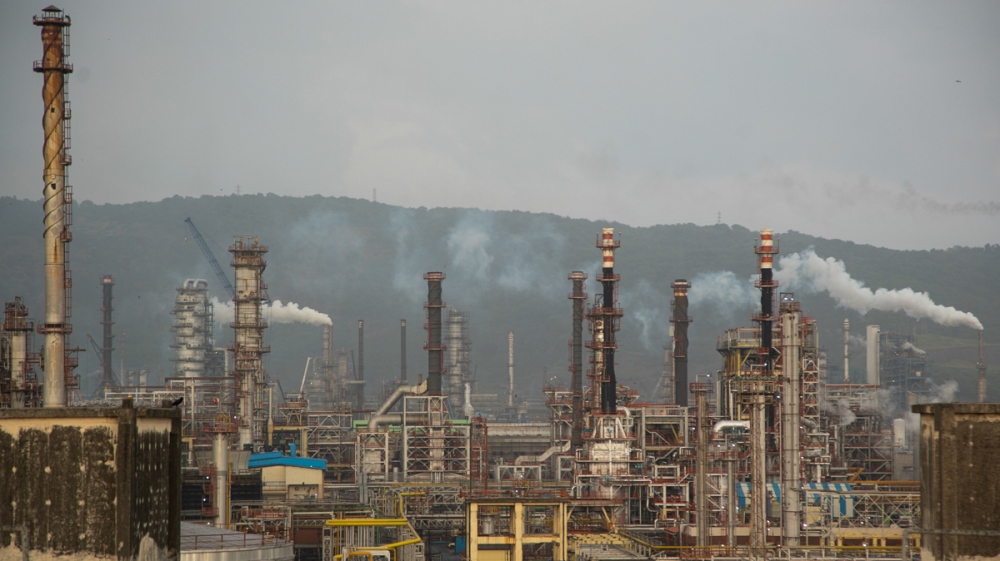In Mumbai, toxic air plagues poor residents of housing colony
Surrounded by chemical factories, more than 5,000 families live in Mahul and many report health problems.

Mumbai, India – After a year of living in her one-bedroom apartment in Mahul, a housing colony on the eastern front of Mumbai, Anita Dhole moved out – to live on a footpath.
The 30-year-old now sleeps on the pavement under a makeshift plastic roof. She cooks in the presence of flies and the occasional rat and walks a fair distance to use a public toilet, an uneasy task for someone who has suffered from polio.
Keep reading
list of 4 itemsAfter the Hurricane
World’s coral reefs face global bleaching crisis
Why is Germany maintaining economic ties with China?
“Staying here is better, at least I can breathe,” said Dhole, who used to be a manager at a private bank. “How could the government dump us there to die?”
Mahul is a housing colony which was built between 2006 and 2009 by the Brihanmumbai Municipal Corporation (BMC), the governing civic body of Mumbai, to place slum dwellers under the government’s “Project Affected People” (PAP) scheme.
The colony is surrounded by 15 chemical factories and two oil refineries.
According to the Indian Express, over the years, 10,000 to 15,000 families, roughly 60,000 people, were moved to Mahul as part of various rehabilitation projects in the city.
Now, the cluster of 72 buildings, holds an estimated 5,500 families, all in 125sq-foot (11.6sq-metre) flats.
On September 3, after hearing writ petitions filed by Mahul residents, the Bombay High Court asked the BMC to stop new residents from moving in and providing financial compensation for existing tenants, so they could seek alternative accommodation.
The court based its verdict on several reports into pollution .

“Each family living in Mahul has lost at least one member after moving there to diseases like tuberculosis, cancer, and asthma,” said Dhole. “It’s a growing cemetery.”
After moving to Mahul in 2017, 56-year-old Narendra Singh lost his daughter and father to cancer. His brother-in-law also died, of respiratory illness, all within a year. Singh, a former manager at a jewellery factory, said they were all healthy before coming to Mahul.
Taking off his shirt, Singh revealed his cracked and flakey skin.
“The pores on my skin have been completely blocked due to a bacterial infection, so I don’t sweat at all,” he said. “I feel like I am burning from inside all the time.”
His doctors fear his health will not improve if he continues to live in Mahul.
They tested the water he uses to bathe, and found a high level of bacteria that worsens his skin condition.
But he is struggling to afford his medication, which costs between 2,000 to 3,000 Indian rupees a day ($27- $41).
“I lost my job because of this skin disease,” he said. “My wife earns only 5,000 Indian rupees ($70) per month. How can we manage with so little?”

Polluted water is one of several problems residents face.
A 2018 report on Mahul by the Collective for Spatial Alternatives, an association of urban researchers, academics, professionals and community organisers, found that the accommodation lacked proper sunlight, ventilation, waste disposal systems and parking. Broken sewage pipes, the association said, explained the water contamination.
As well as the various health conditions that Laxmi Pawar and her almost dozen relatives suffer from, the 34-year-old, who moved to Mahul in 2017, is also concerned about her children’s schooling.
For the 5,500 families of Mahul housing colony, there is a single BMC school – which offer poor-quality education.
The closest private schools are in Mumbai’s eastern suburbs, which is connected to Mahul by a single public bus that runs every hour. A rickshaw ride costs 100 Indian rupees ($1.40).
“The bus is too overcrowded to step foot in and we can’t afford private transport travel expenses,” said Pawar. “There is no future for my children here.”

Along with other low-income women, she was a domestic worker before moving to the colony and has not found any employment since.
But leaving Mahul is not an option.
“A single room in Mumbai costs at least 10,000 Indian rupees ($140),” Pawar said, referring to one of the world’s most expensive cities. “My husband is an office peon. He only earns 12,000 ($167) every month.”
On October 28 last year, more than 800 Mahul residents, including Pawar, launched an indefinite protest opposite the 100-km (61-mile) Tansa Pipeline in Chembur, an upmarket eastern suburb of Mumbai.
It was there that over a year ago, the homes of 3,000 families were rehabilitated to Mahul to create a jogging and cycling track in its place.
“We aren’t going to stop our [protests] until they give people their rights,” said Jamila Eathakula Begum, a participant and housing rights activist. “Mahul is the government’s strategic way to leave poor people to die a slow death. Would they ever have the audacity to allot such a place to rich citizens?”
The BMC is planning to appeal the September 3 verdict to stop new residents from moving in.
“New Delhi is such a polluted city, but is it being evacuated?” said Keshav Ubale BMC assistant commissioner (Estates). “Similarly, there is no reason why people need to leave Mahul. Pollution levels only need to be controlled there.”
The Bombay High Court has given the BMC 12 weeks since its September verdict to rehabilitate Mahul residents. But since then, no action has been taken.
“They (the BMC) justify themselves by claiming that they gave us a home in exchange for the one they took away,” said Dhole. “But what’s the point of living in a house where your families are dying?”
